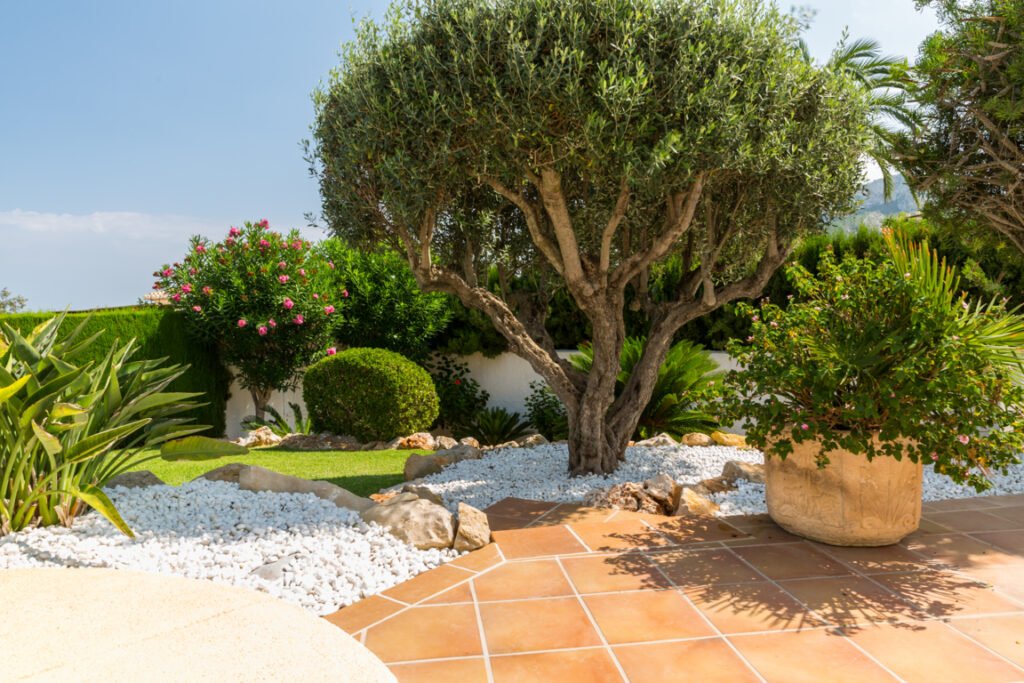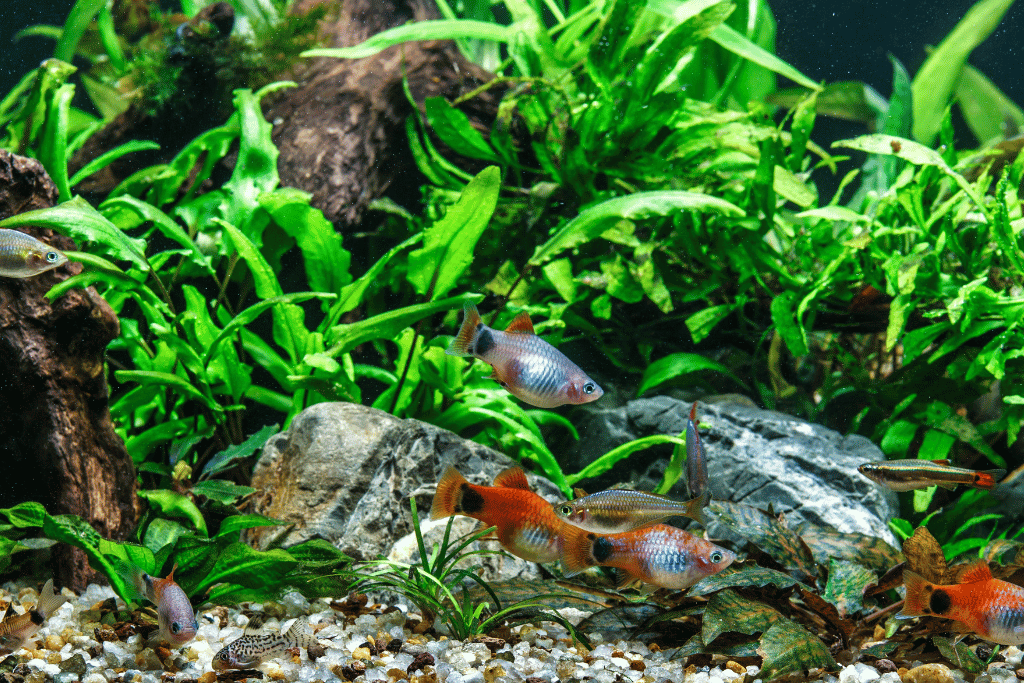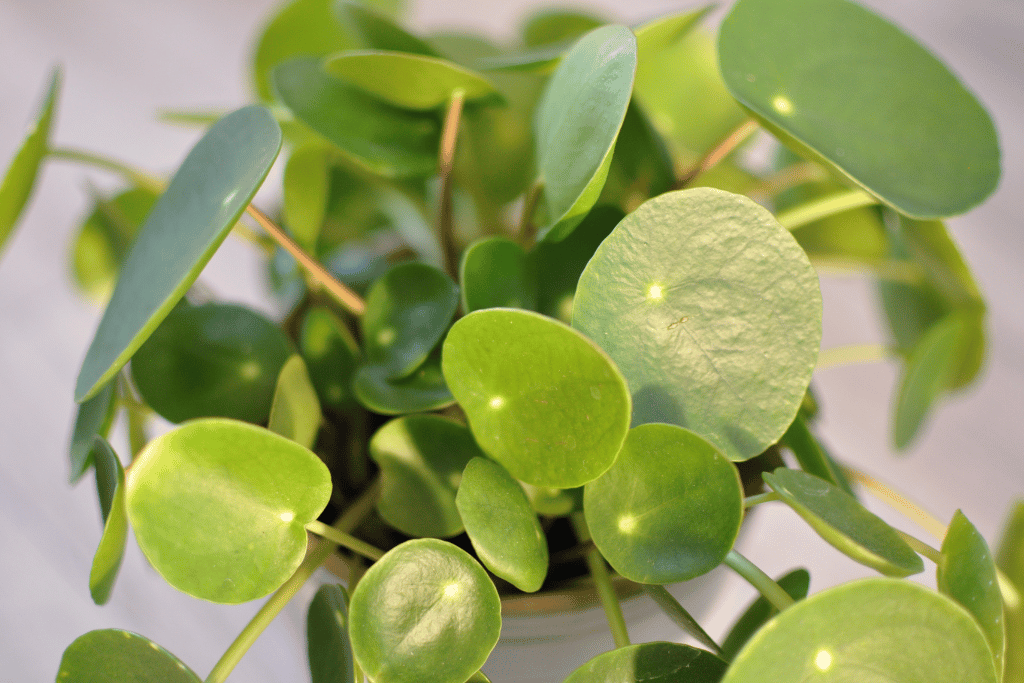
Have you ever wondered why some plants are called “Money Plants”? Well, in this article, I’ll unveil the intriguing history behind that name and provide insights on various types of Money Plant that exist on God’s green earth.
You see, Money Plants aren’t named after a secret stash of cash hidden in their pots (although that would be quite the discovery!). Instead, their moniker comes from a fascinating belief. In some cultures, these plants are thought to bring prosperity, wealth, and good fortune to those who care for them. They’re believed to attract positive energy and, metaphorically, money, into your life.
But, we’re not here to explore the folklore and superstitions surrounding Money Plants only. No, we’re diving deep into the botanical nitty-gritty, uncovering the various types of Money Plants that exist, each with its unique charm and care requirements. So, get ready to unearth the secrets of these green treasures and find out which one might become your very own guardian of good fortune.
1. Golden Pothos
Scientific Name: Epipremnum aureum
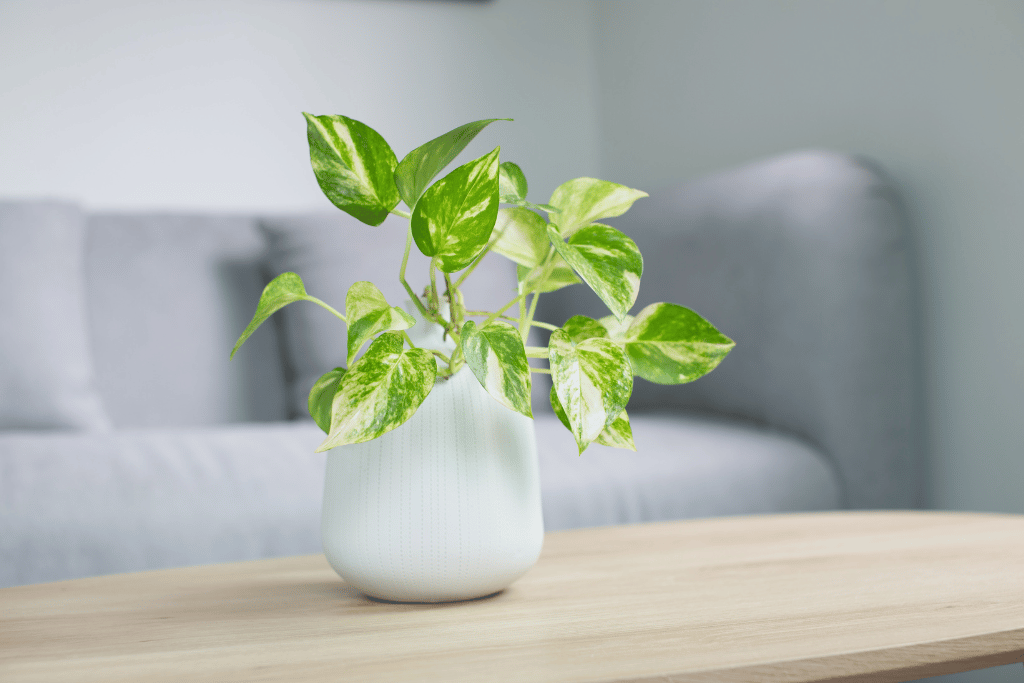
Starting our list of the best types of money plant – our very first contender is none other than the Golden Pothos. It boasts heart-shaped leaves adorned with green and yellow variegation, adding a pop of color to any room.
This iconic plant is revered for its air-purifying qualities, making it an excellent choice for beginners.
The scientific name Epipremnum aureum reflects its natural ability to climb using aerial roots, enhancing its adaptability and ornamental value.
Golden Pothos is not only visually appealing but also an effective air purifier, removing harmful toxins like formaldehyde and xylene from the air, promoting a healthier living environment.
To ensure its well-being, provide moderate, indirect sunlight. Allow the soil to dry slightly between waterings. Overwatering can lead to root rot, so be cautious with watering frequency.
2. Jade Pothos
Scientific Name: Epipremnum aureum ‘Jade’
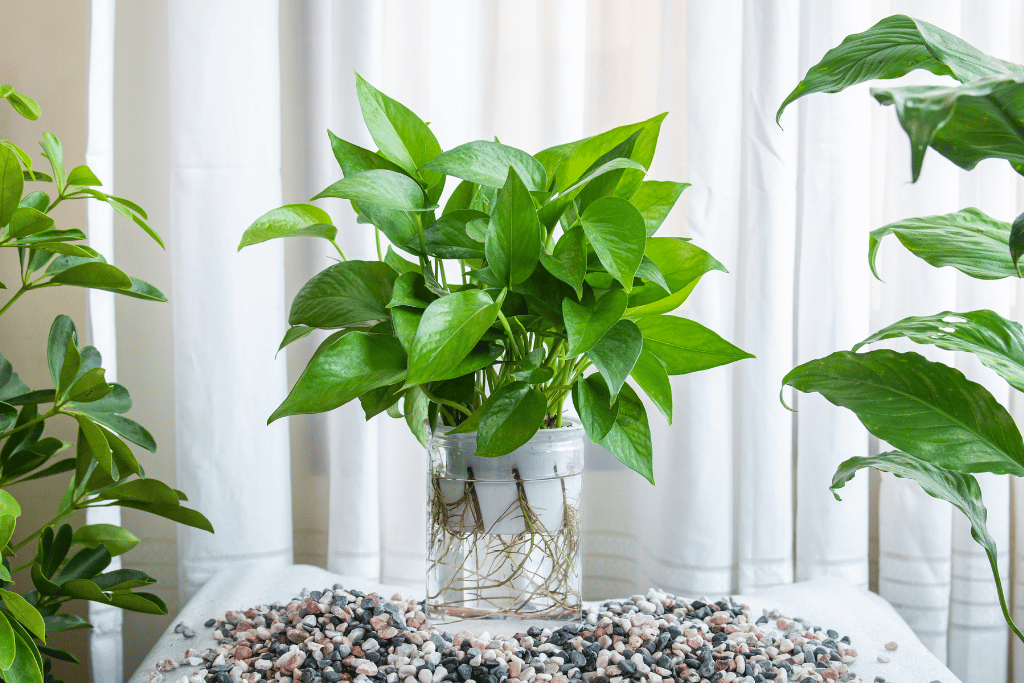
Jade Pothos features glossy, dark green leaves and grows in a compact, bushy manner. Its lush, vibrant foliage adds a touch of elegance to any setting.
A remarkable quality of Jade Pothos is its ability to thrive in low light conditions, making it an ideal choice for offices or rooms with limited access to sunlight. This adaptability is a testament to its hardiness and resilience.
To ensure the well-being of your Jade Pothos, place it in an area with indirect light. Water sparingly and allow the top inch of soil to dry out before the next watering.
3. Marble Queen Pothos
Scientific Name: Epipremnum aureum ‘Marble Queen’
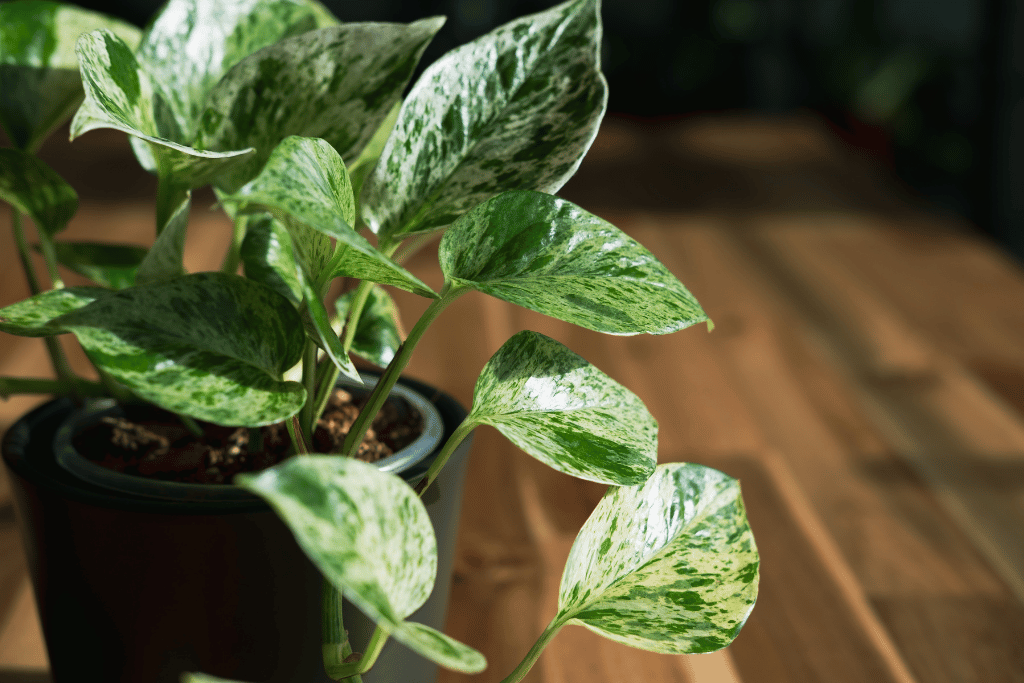
Moving on with our list of types of money – next up, is the plantMarble Queen Pothos. It showcases marbled white and green leaves, creating a striking visual contrast. The variegation resembles a delicate marble pattern, adding sophistication to your indoor garden.
One captivating aspect of Marble Queen Pothos is its popularity as a hanging plant. Its cascading growth habit makes it perfect for decorative hanging baskets, allowing its beauty to cascade gracefully from above.
Ensure this plant receives bright, indirect sunlight. Keep the soil evenly moist but avoid waterlogging, as it can lead to root rot.
4. Neon Pothos
Scientific Name: Epipremnum aureum ‘Neon’
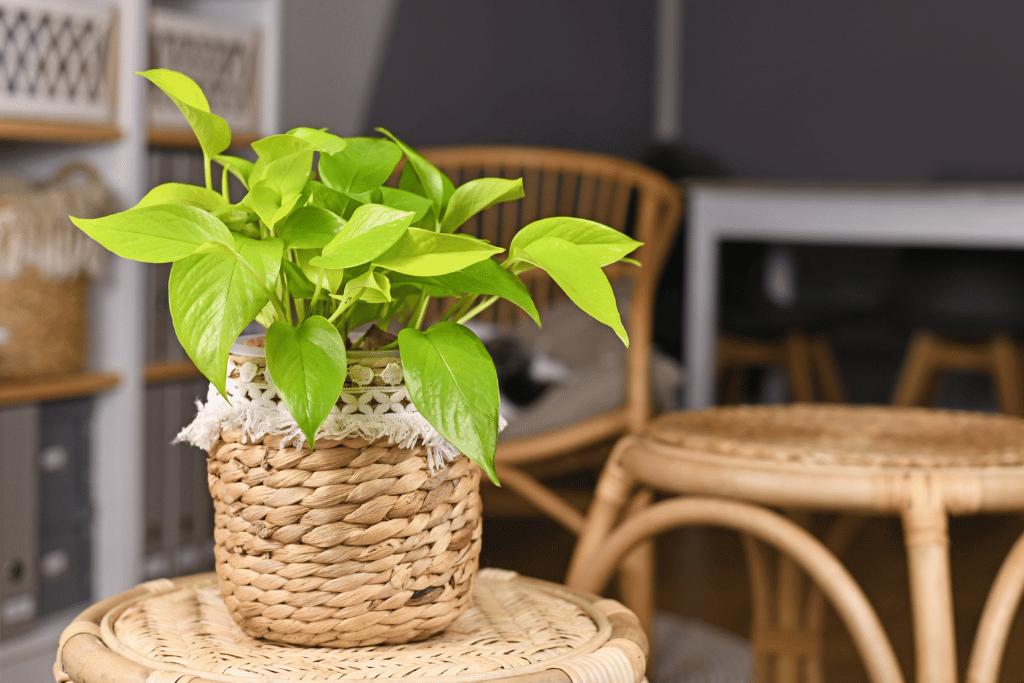
Neon Pothos lives up to its name with neon-bright, chartreuse-colored leaves that instantly grab attention. The vibrant foliage makes it a standout choice for any indoor garden.
While Neon Pothos can adapt to various light conditions, it thrives in bright, indirect sunlight. This preference for brighter light intensifies the neon hue of its leaves, creating a captivating visual display.
To ensure your Neon Pothos thrives, place it in a location with bright, indirect sunlight. Allow the top layer of soil to dry out before watering. Avoid overwatering, as it can lead to root rot.
5. Manjula Pothos (Epipremnum aureum ‘Manjula’)
Scientific Name: Epipremnum aureum ‘Manjula’
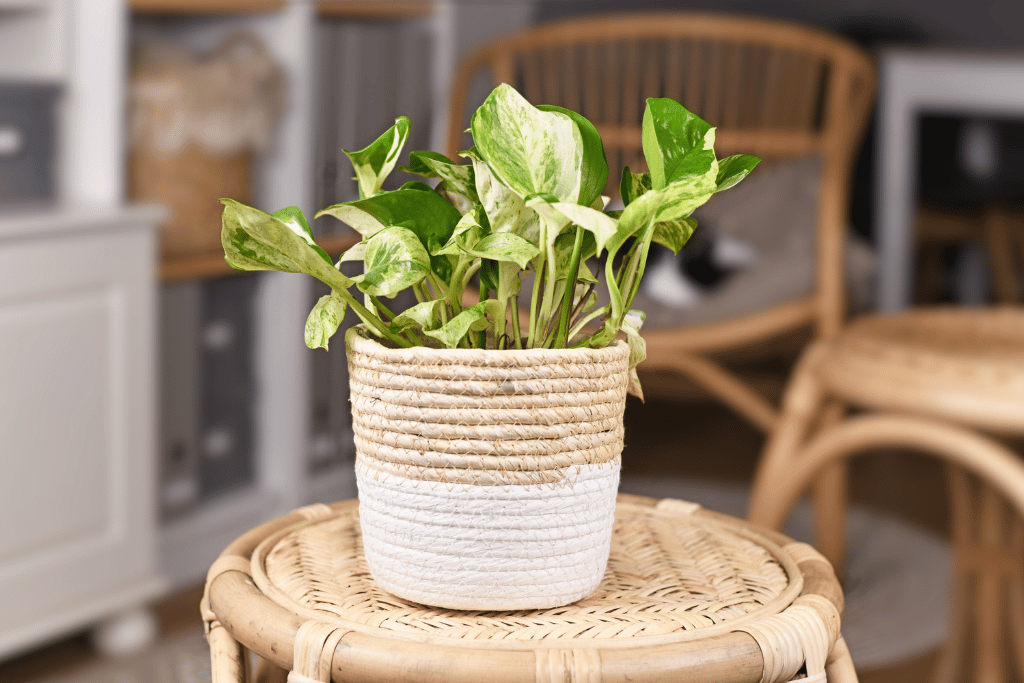
Manjula Pothos features broad leaves with creamy-white and silvery-green variegation, creating an elegant and aesthetically pleasing look. Its graceful appearance is a favorite among plant enthusiasts.
Manjula Pothos is a relatively new cultivar known for its unique appearance and low maintenance requirements. Its variegation patterns differ from other Pothos varieties, adding a touch of sophistication to your collection.
Place your Manjula Pothos in bright, indirect sunlight to maintain its variegation. Keep the soil consistently moist but avoid waterlogging. Ensure proper drainage to prevent root rot.
6. N’Joy Pothos
Scientific Name: Epipremnum aureum ‘N’Joy’
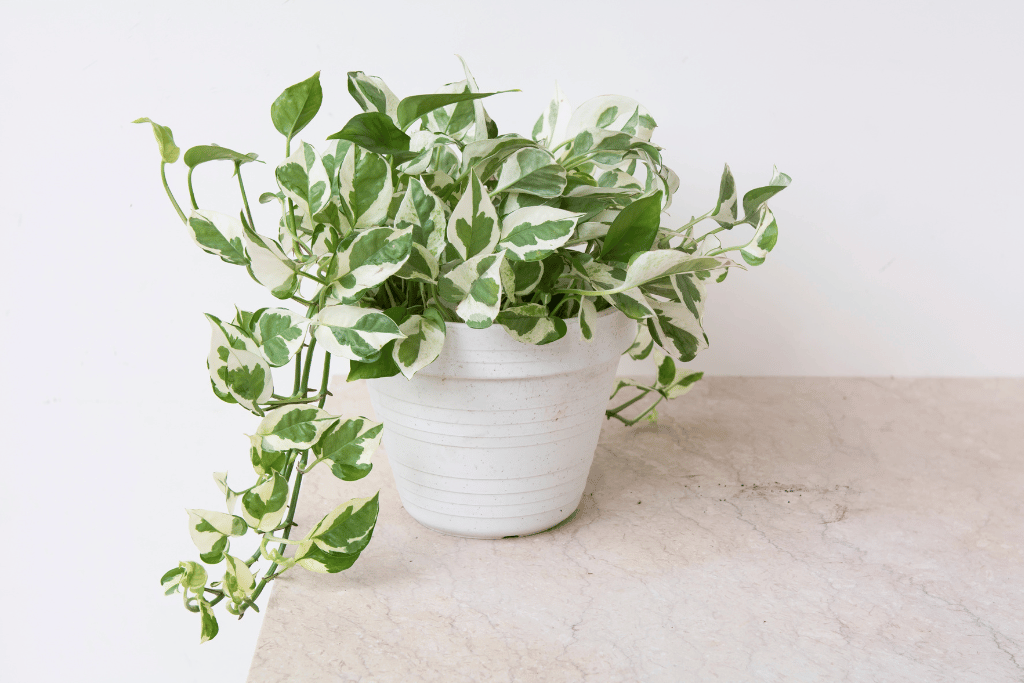
N’Joy Pothos showcases slender, heart-shaped leaves adorned with creamy-white streaks, creating a delightful contrast. Its elegant appearance is sure to brighten up your living space.
One notable feature of N’Joy Pothos is its adaptability to different humidity levels. It can thrive in varying indoor conditions, making it an excellent choice for homes with fluctuating environments.
To ensure your N’Joy Pothos flourishes, provide moderate, indirect light. Maintain even moisture in the soil, and water when the top inch feels dry. Avoid overwatering, which can harm the plant’s roots.
7. Silvery Ann Pothos
Scientific Name: Epipremnum aureum ‘Silvery Ann’
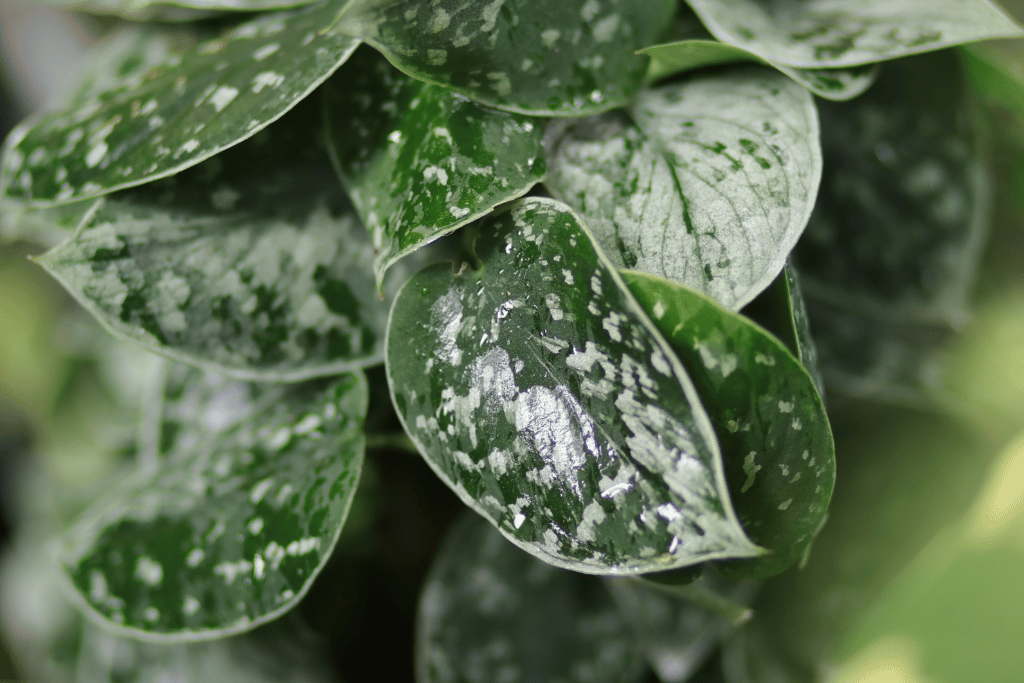
Silvery Ann Pothos features green leaves with striking silver streaks, creating an enchanting silvery-green effect. Its unique variegation makes it a captivating addition to your indoor garden.
The variegation on Silvery Ann Pothos intensifies when exposed to bright light. This plant can adapt to various lighting conditions but thrives in environments with ample indirect sunlight.
Place your Silvery Ann Pothos in an area with bright, indirect light. Maintain even moisture in the soil, and water when the top layer feels dry. Proper drainage is essential to prevent waterlogged roots.
8. Silver Money Plant/Satin Pothos
Scientific Name: Scindapsus pictus
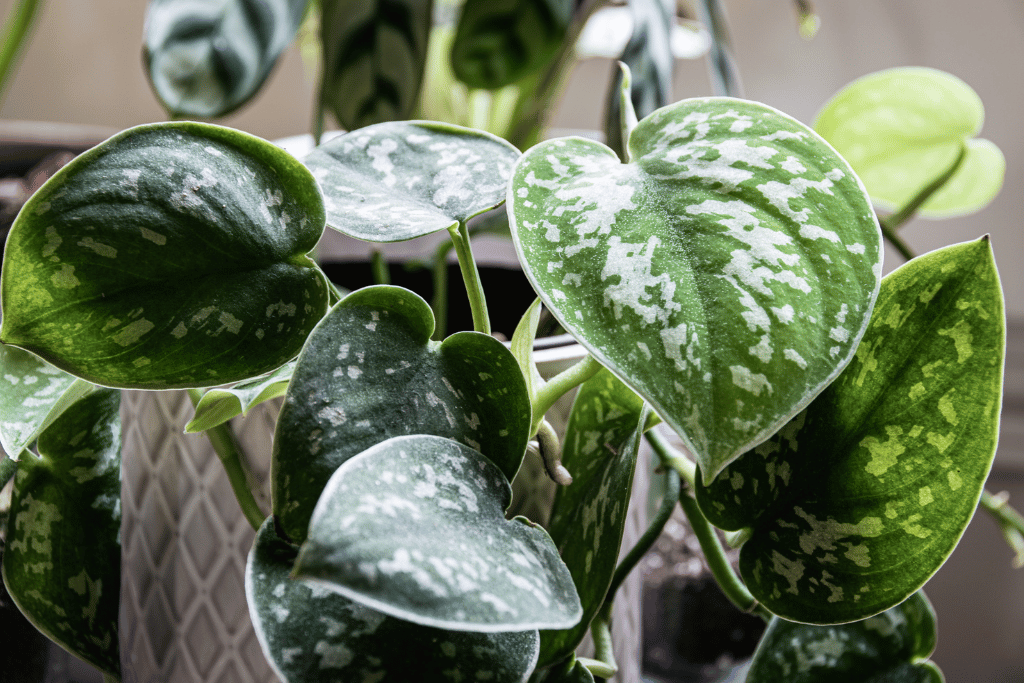
Unlike other money plants, Satin Pothos has unique, satiny-textured leaves with silver markings. These leaves are an enchanting shade of green with silver splashes, creating a lovely contrast.
Satin Pothos is often confused with Pothos due to their similar growth patterns. However, they belong to different plant genera. Satin Pothos is part of the Scindapsus genus, while Pothos belongs to the Epipremnum genus.
To keep your Satin Pothos thriving, place it in low to moderate light conditions. Water the plant when the top inch of soil feels dry. Proper drainage is essential to prevent water accumulation at the root level.
9. Silver Vine
Scientific Name: Scindapsus pictus ‘Argyraeus’

Silver Vine boasts heart-shaped leaves adorned with silver spots, resembling a starry night sky. The silver speckles on its leaves add a touch of whimsy to your indoor garden.
While Silver Vine is a close relative of Satin Pothos, it exhibits distinct characteristics, including its leaf shape and silver markings. The ‘Argyraeus’ cultivar is particularly known for its silver-flecked foliage.
Provide indirect light for your Silver Vine plant, avoiding direct sunlight that can scorch the leaves. Water the plant moderately, allowing the soil to partially dry out between waterings.
10. Cebu Blue Pothos
Scientific Name: Epipremnum pinnatum ‘Cebu Blue’
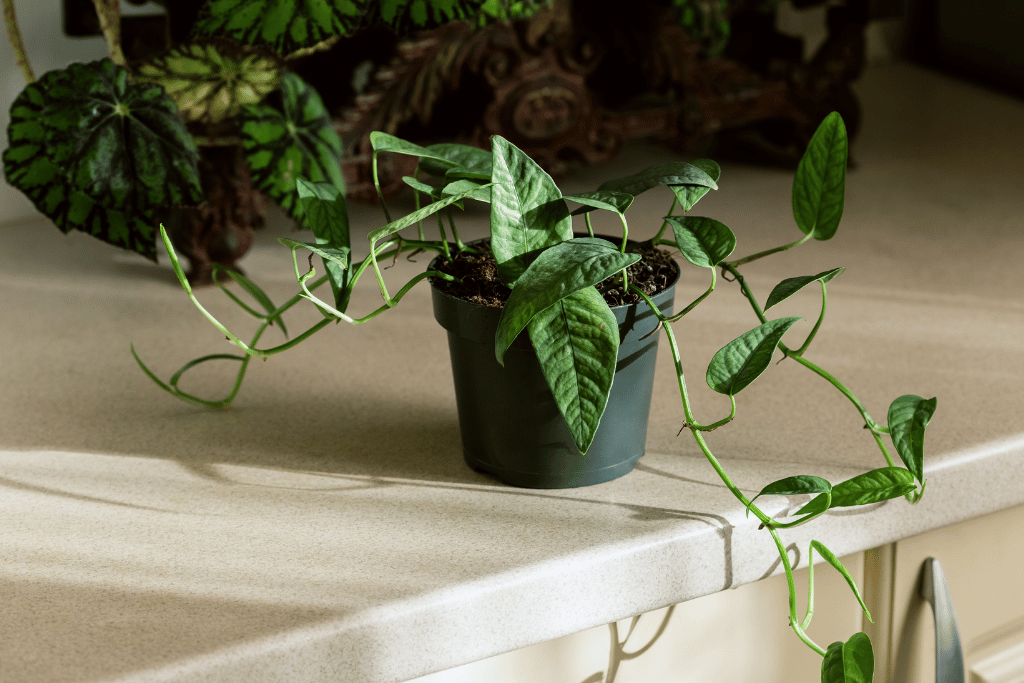
Cebu Blue Pothos is known for its striking blue-green leaves and climbing habit. Its leaves are elongated and slightly serrated, contributing to its unique visual appeal.
Unlike many other money plants, Cebu Blue Pothos is often grown as a trailing or climbing vine. It thrives in hanging baskets or when trained to climb on trellises or supports, creating an impressive display.
Place your Cebu Blue Pothos in a location with bright, indirect sunlight. Water it when the top inch of soil dries out. Adequate support or a trellis can encourage vertical growth, enhancing its ornamental value.
11. Hawaiian Pothos
Scientific Name: Epipremnum pinnatum ‘Aureum’
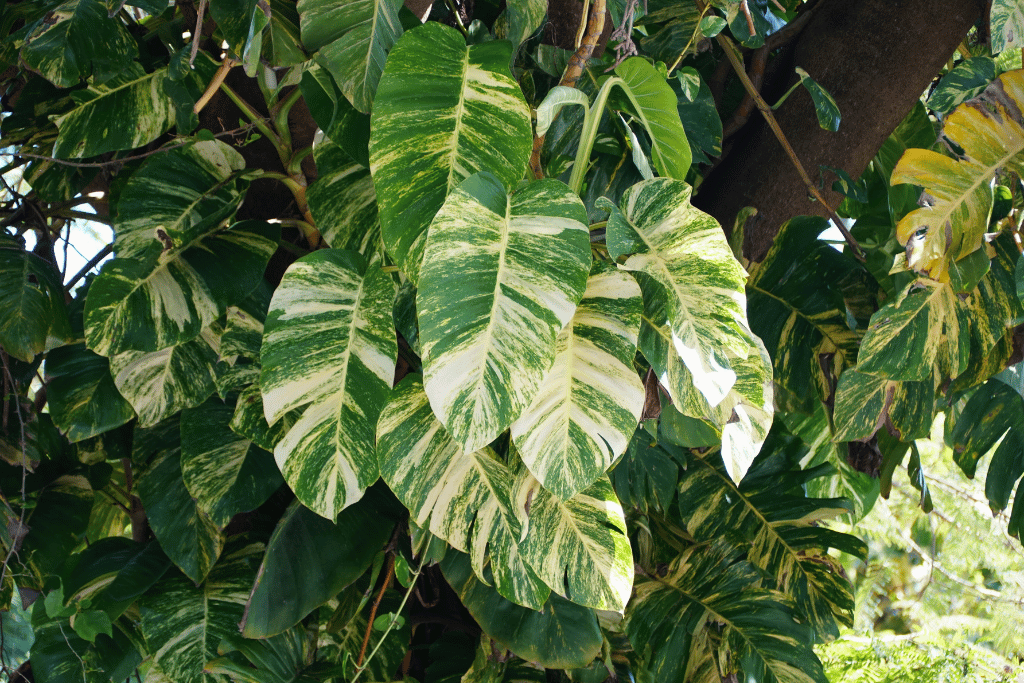
Hawaiian Pothos showcase vibrant, lime-green leaves with golden-yellow variegation. The contrasting colors make it a visually appealing addition to your indoor garden.
Despite its name, Hawaiian Pothos is native to the Solomon Islands rather than Hawaii. This plant’s moniker adds a touch of tropical allure to its presence.
Provide your Hawaiian Pothos with bright, indirect light to maintain its variegation. Water it when the top layer of soil dries out, ensuring proper drainage to prevent root issues.
12. Pearls and Jade Pothos
Scientific Name: Epipremnum aureum ‘Pearls and Jade’
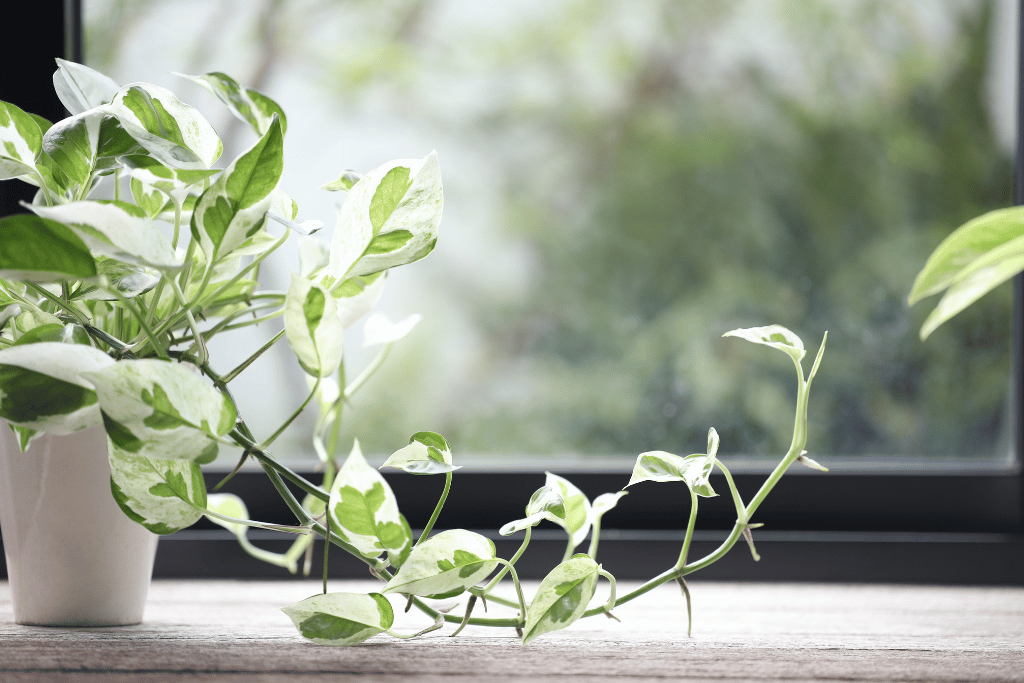
Pearls and Jade Pothos feature small, dainty leaves with a delightful combination of green and white variegation. This compact cultivar adds an element of charm to your indoor garden.
Pearls and Jade Pothos is an excellent choice for the types of money plant that occupy small spaces, thanks to its compact growth habit. It’s ideal for decorating shelves, desks, or tabletops with its elegant appearance.
Ensure your Pearls and Jade Pothos receive bright, indirect light for optimal growth. Keep the soil consistently moist but avoid overwatering, as it can harm the plant’s roots.
13. Glacier Pothos
Scientific Name: Epipremnum aureum ‘Glacier’
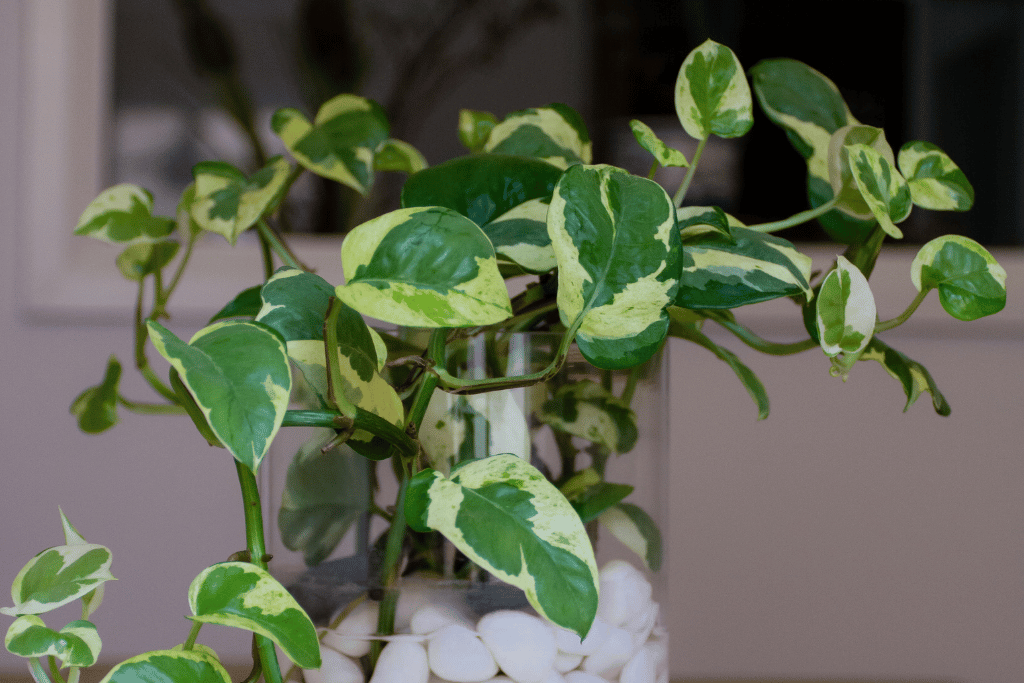
Glacier Pothos is renowned for its exquisite leaves adorned with a blend of green, white, and silver variegation. The variegation creates a stunning icy effect, lending a touch of elegance to your indoor space.
Glacier Pothos is a captivating variety known for its striking appearance. The variegation is truly unique, and it thrives in conditions with bright, indirect sunlight.
Place your Glacier Pothos in an area with bright, indirect light to enhance its variegation. Maintain even moisture in the soil, allowing the top layer to dry out before the next watering. Proper drainage is essential for its health.
14. Swiss Cheese Plant
Scientific Name: Monstera deliciosa
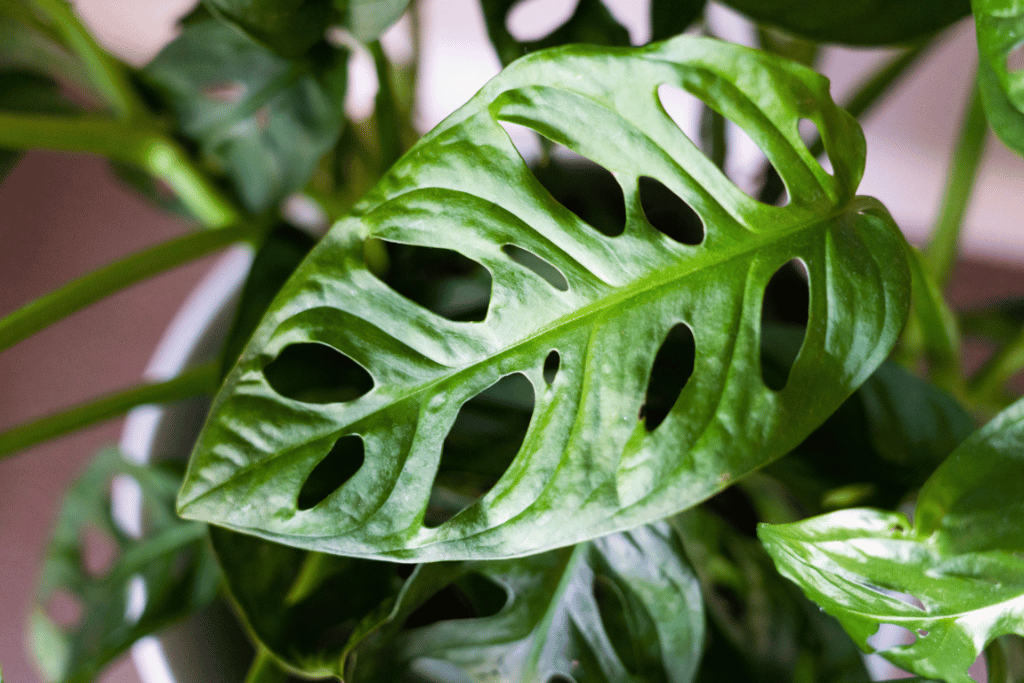
Adding to our list of money plants is the Swiss Cheese Plant, scientifically known as Monstera deliciosa. With its iconic split leaves resembling Swiss cheese, this tropical beauty is an eye-catching addition to any indoor jungle.
The Monstera deliciosa is known for its air-purifying qualities, making it an excellent choice for enhancing indoor air quality. It’s relatively easy to care for, thriving in moderate, indirect light and requiring occasional watering when the top inch of soil feels dry.
15. Money Tree
Scientific Name: Pachira aquatica

Now, let’s introduce the Money Tree, scientifically known as Pachira aquatica. This plant is often associated with prosperity and good fortune due to its unique braided trunk and five-lobed palmate leaves. It’s considered a symbol of wealth and financial success.
Money Trees are relatively low-maintenance, requiring bright, indirect light and allowing the soil to dry out partially between waterings. Many people believe that placing a Money Tree in their home or office can bring financial luck, making it a popular choice among plant enthusiasts.
16. Lunaria
Scientific Name: Lunaria annua
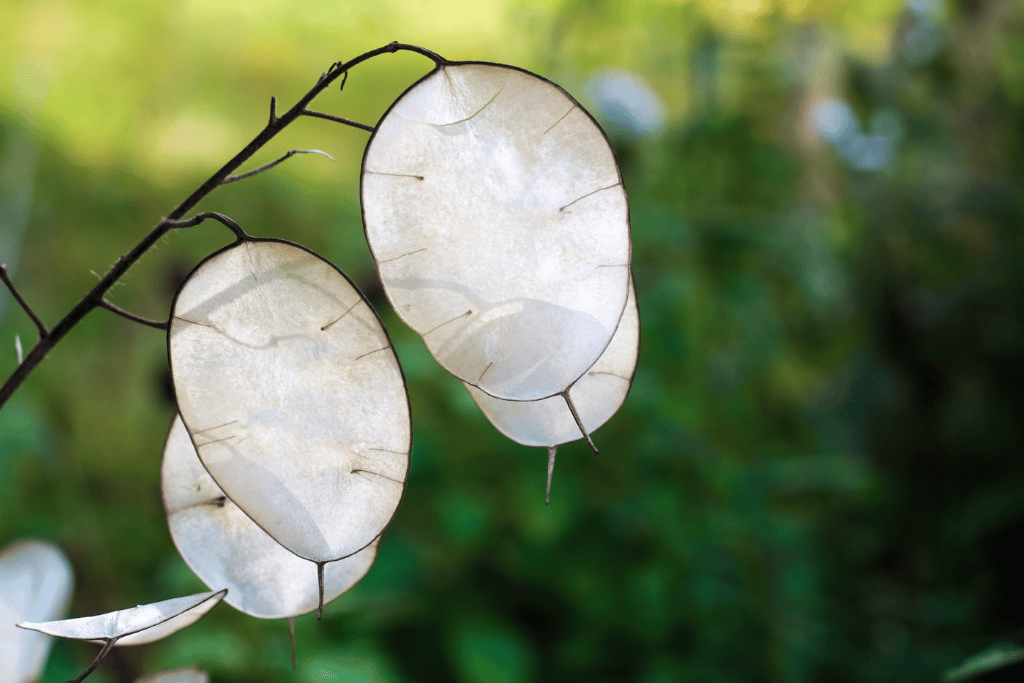
Completing our list of types of money plant is Lunaria, also known as the Money Plant or Silver Dollar Plant. Lunaria annua is known for its unique silvery, disc-shaped seed pods that resemble coins, hence its association with money.
This biennial plant produces clusters of purple or white flowers in the spring and summer, eventually forming those distinctive seed pods. The pods can be dried and used in floral arrangements or crafts, adding a touch of monetary symbolism to your home decor.
To grow Lunaria, provide it with well-draining soil and moderate sunlight. It’s a low-maintenance plant that can add a charming and symbolic element to your garden.
Benefits of Money Plants
Money plants are not just beautiful home decor; they offer a range of advantages for your living space. Here’s a closer look at the benefits all types of money plant bring:
Air Purification:
One of the most significant advantages of having money plants is their ability to cleanse the air in your home. These plants are excellent at absorbing pollutants and toxins, such as formaldehyde and benzene, commonly found in indoor environments.
By having money plants around, you can enjoy fresher and healthier air.
Positive Energy:
According to the principles of Feng Shui, money plants are believed to attract positive energy, wealth, and prosperity. Placing them strategically in your home, particularly in the southeast corner, is thought to enhance financial luck. While it may not guarantee a sudden windfall, the positive vibes they bring can contribute to a more optimistic atmosphere.
Ease of Maintenance:
Money plants are ideal for those with busy lifestyles or limited gardening experience. They are remarkably low-maintenance and forgiving. They can adapt to various lighting conditions, including low light, and require minimal attention. This makes them a perfect choice for beginners and anyone seeking a hassle-free indoor plant.
Decorative Appeal:
Money plants are not just beneficial; they are also visually appealing. Their heart-shaped leaves come in various shades of green and variegations, adding a touch of natural beauty to your interior decor. You can grow them in hanging baskets, pots, or let them trail gracefully from shelves or mantels, making them a versatile choice for any space.
Stress Reduction:
Caring for indoor plants like money plants can be a therapeutic and stress-relieving activity. Observing their growth and tending to their needs can offer a sense of accomplishment and relaxation. The calming effect of greenery can contribute to a more peaceful and serene atmosphere in your home.
Money Plant Myths

Now, let’s dispel some common myths and misconceptions about money plants:
Money Growth: While money plants are associated with financial luck in Feng Shui, they do not actually produce money. Their name is derived from the belief that they bring wealth, but they won’t magically generate currency.
Indestructibility: Money plants are hardy, but they are not indestructible. Neglecting their basic care needs, such as watering and appropriate lighting, can lead to problems like yellowing leaves or slowed growth. Regular care is still necessary to keep them healthy.
Rapid Growth: Money plants do grow, but their growth rate can vary depending on factors like light, temperature, and humidity. Expect gradual growth over time rather than rapid, dramatic changes.
Feng Shui Rules: While Feng Shui principles suggest specific placements for money plants to maximize their positive energy, it’s important to remember that they are just one element of a larger Feng Shui practice. Placing a money plant in the right spot can enhance the flow of positive energy, but it should be part of a holistic approach to Feng Shui.
Types of Money Plant in Feng Shui
1. Heartleaf Philodendron (Philodendron hederaceum):
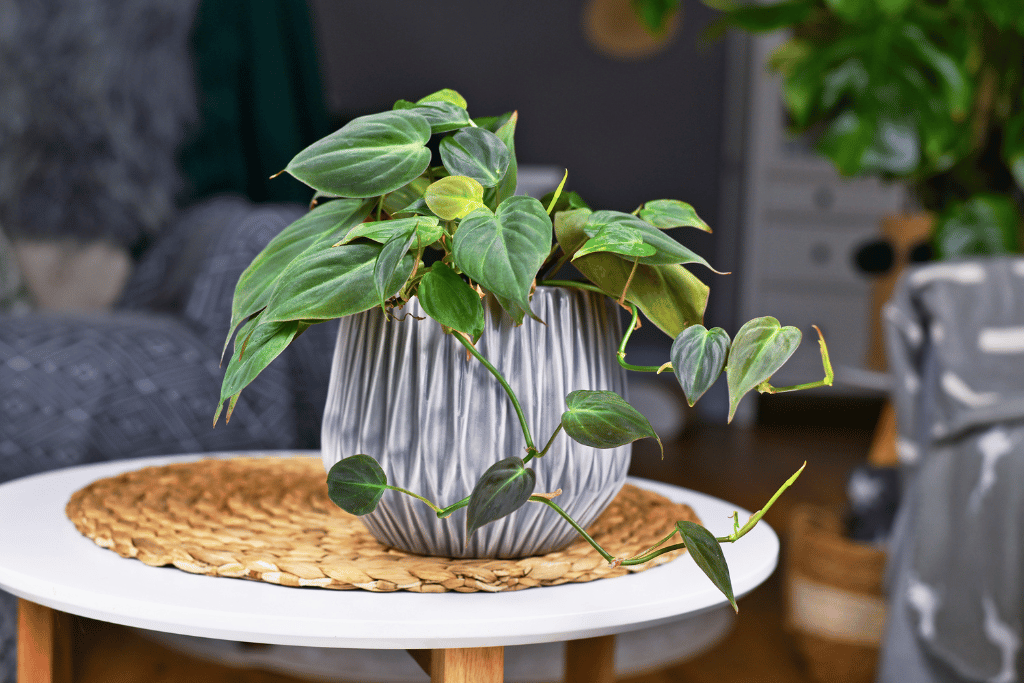
The Heartleaf Philodendron is a beloved choice for those seeking financial prosperity and positive energy in their living spaces. Its heart-shaped leaves symbolize love and good fortune, making it a popular choice for enhancing wealth and happiness.
This plant is not only aesthetically pleasing but also easy to care for, making it an ideal option for beginners. To attract wealth and love, place the Heartleaf Philodendron in the southeast corner of your home or workspace, following Feng Shui principles.
2. Birkin Plant (Epipremnum aureum ‘Birkin‘):
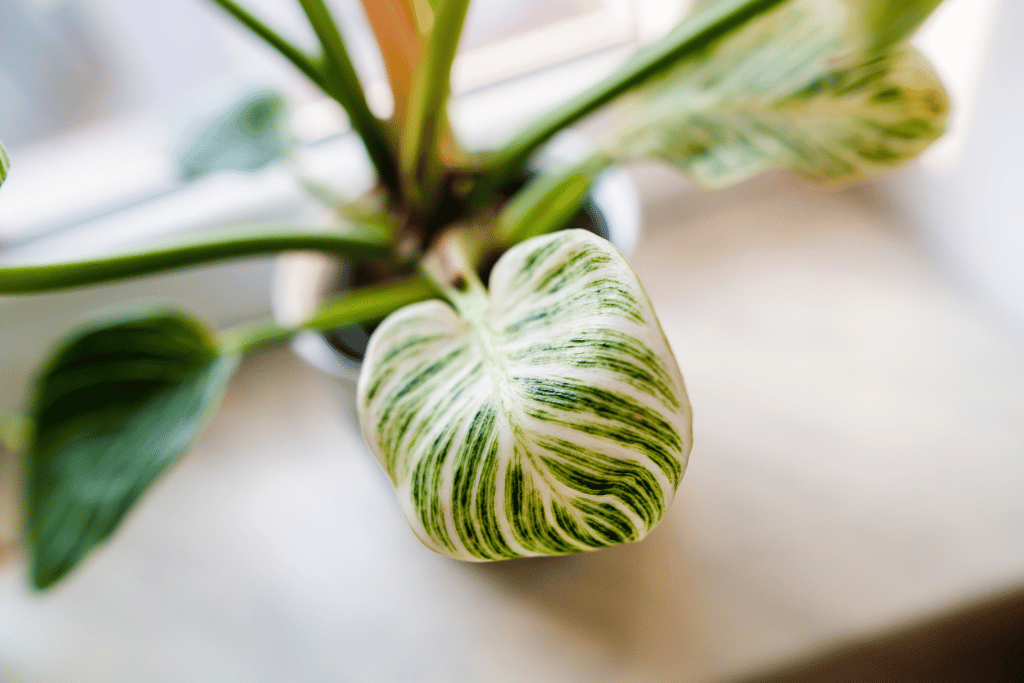
The Birkin Plant is a newer addition to the world of indoor plants but has quickly gained popularity for its unique and striking appearance. It features glossy green leaves with bold, creamy-white stripes resembling a stylish Birkin handbag.
In Feng Shui, the Birkin Plant is associated with attracting abundance and prosperity. Its distinctive foliage makes it an attractive addition to any room. To invite financial success, consider placing the Birkin Plant in the southeast or east areas of your home or office.
3. Pothos Plant (Epipremnum aureum):
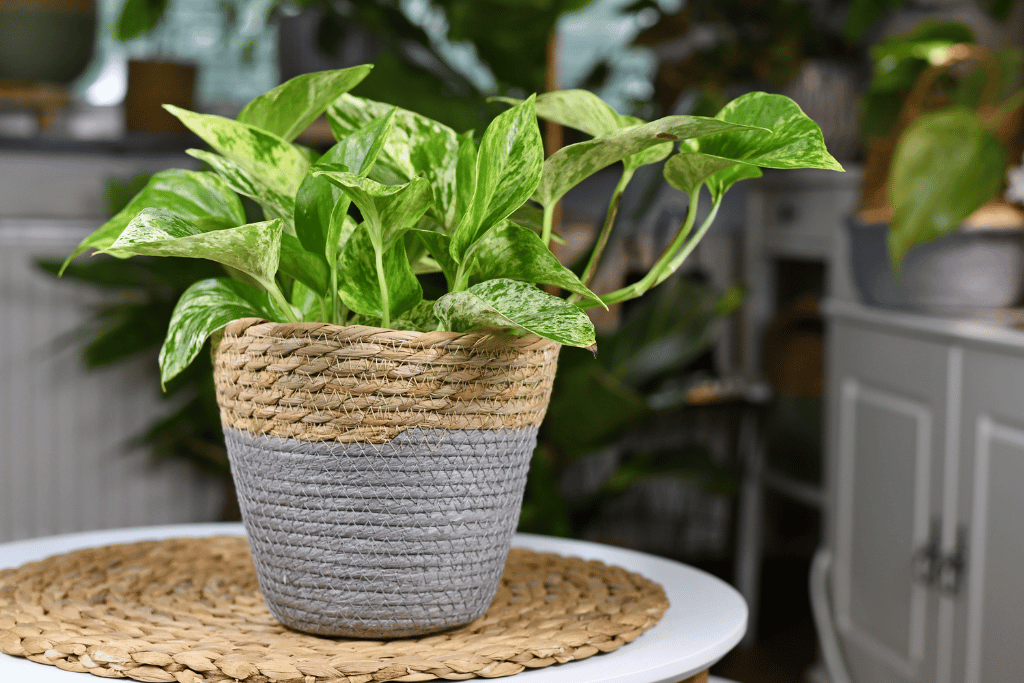
The pothos plant has many names and varieties. However, the most common name you’ll hear is the Devil’s Ivy. This plant is a classic choice in Feng Shui for enhancing wealth and positive energy. With its heart-shaped leaves, this plant has long been associated with prosperity and good luck.
It is not only resilient but also adaptable to different environments, making it a favorite among plant enthusiasts. To harness its Feng Shui energy, position the Pothos Plant in the southeast corner of your living space. Its simplicity and ease of care make it an excellent choice for those looking to introduce Feng Shui principles into their homes.
4. Lucky Bamboo (Dracaena sanderiana):
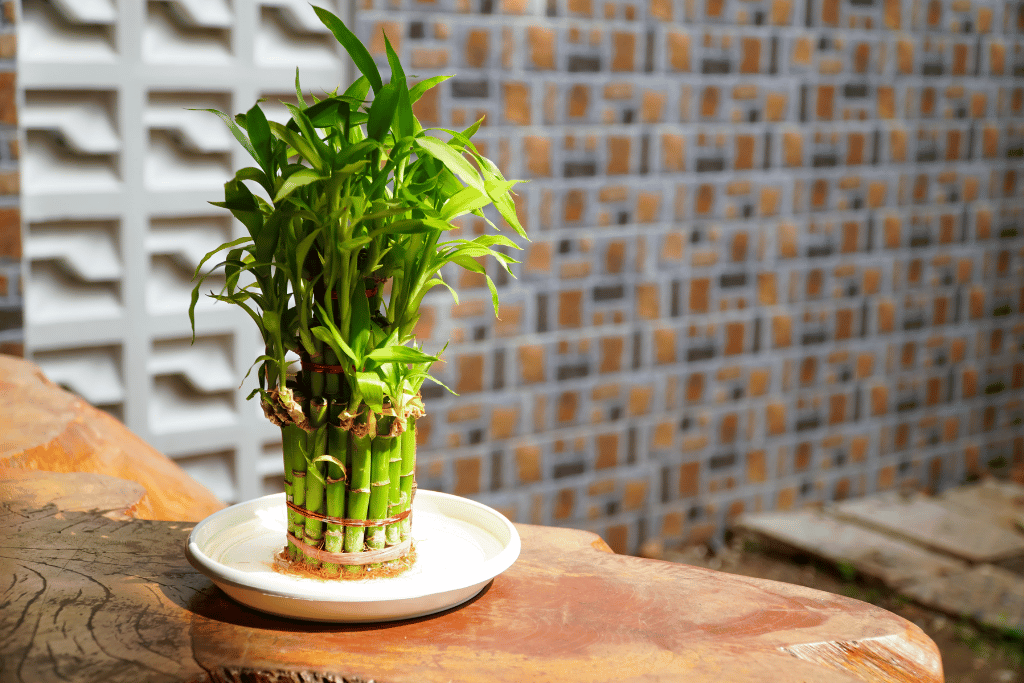
Lucky Bamboo, despite its name, is not actually a bamboo but a member of the Dracaena family. It is highly regarded in Feng Shui for its ability to attract positive energy, good luck, and prosperity. Lucky Bamboo is often arranged in various numbers of stalks, with each number carrying different meanings.
For instance, three stalks represent happiness, wealth, and longevity, while five stalks symbolize the five elements of Feng Shui. Place your Lucky Bamboo in the east or southeast corner of your home or office, and keep it in a container with water or soil to ensure its well-being.
5. Chinese Money Plant (Pilea peperomioides):
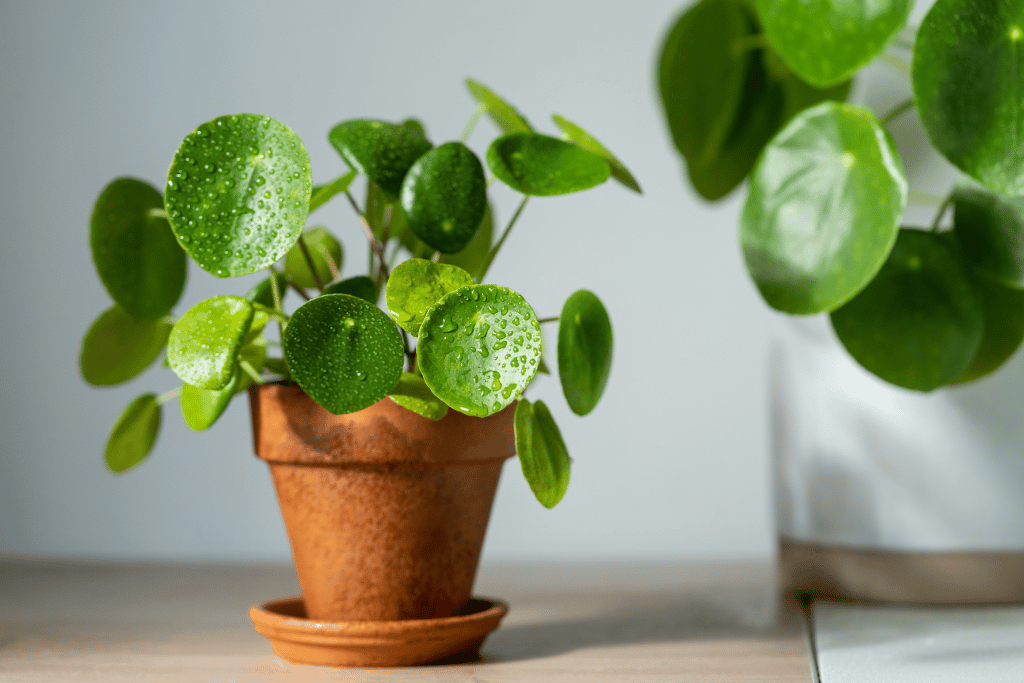
It goes by the name of Pancake Plant. This plant has gained popularity for its unique, round, coin-shaped leaves, which are thought to symbolize wealth and fortune in Feng Shui. It is believed that this plant brings financial luck and prosperity to its owner.
The Chinese Money Plant is relatively easy to care for and makes an attractive addition to any room. To maximize its Feng Shui benefits, place it in the southeast corner or the wealth sector of your living space.
Alocasia Polly (Alocasia amazonica ‘Polly’): Alocasia Polly, with its distinctive arrowhead-shaped leaves and striking dark green foliage, is another plant associated with prosperity and positive energy.
It is believed to promote financial growth and abundance. Alocasia Polly is more challenging to care for than some other money plants, as it requires higher humidity and careful watering. To harness its Feng Shui energy, place it in the southeast or east areas of your home or office, but be prepared to provide the necessary care it needs to thrive.
Money Plant Care
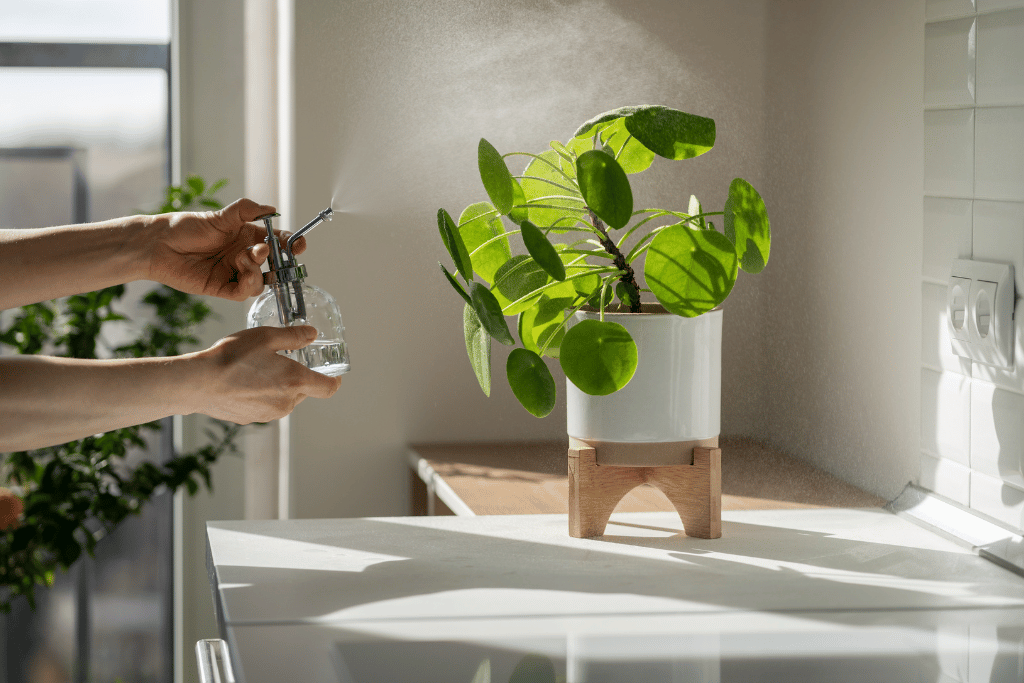
Taking care of your money plant is relatively straightforward. Here are detailed care instructions to help your money plant thrive:
Light: Money plants prefer indirect or low light conditions. They can tolerate some direct sunlight but avoid placing them in intense, scorching sunlight, as it can damage their leaves. The ideal spot is near a window with filtered sunlight.
Watering: Water your money plant when the top inch (2.5 cm) of the soil feels dry to the touch. Be cautious not to overwater, as this can lead to root rot. Ensure proper drainage to prevent water from pooling in the pot.
Temperature: Maintain a comfortable indoor temperature for your money plant, ideally between 65-80°F (18-27°C). Avoid exposing them to drafts, as sudden temperature fluctuations can stress the plant.
Humidity: Money plants thrive in moderately humid conditions. If your home has low humidity, consider occasional misting to provide the moisture they need.
Pruning: To encourage bushier growth and maintain a pleasing shape, trim any leggy or excessively long vines. You can also remove any yellowing or dead leaves to keep the plant looking healthy.
Fertilizing: Feed your money plant with a balanced liquid fertilizer diluted to half strength during the growing season (spring and summer) every 2-4 weeks. Reduce or stop fertilizing during the dormant winter months.
Support: If you want your money plant to climb or trail along a specific path, provide a trellis, moss pole, or other supports to guide its growth.
Final Words
Incorporating different types of money plant into your living space not only adds a touch of natural beauty but also brings with it the potential for enhanced positive energy, financial prosperity, and overall well-being.
Remember that while these money plants are associated with wealth and fortune, their true power lies in your intention and care. Proper placement, regular maintenance, and a positive mindset are essential to maximizing the positive energy they can attract.


